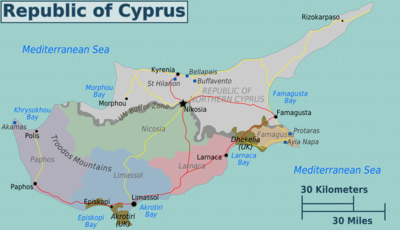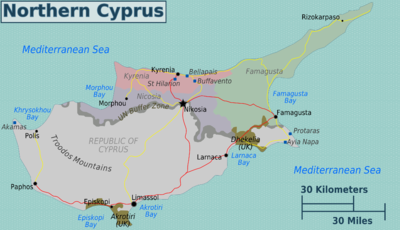
Cyprus is an island in the eastern Mediterranean that culturally belongs to Europe. Geographically, the island belongs to the near East.
division
- Republic of cyprus - Southern part of the island, member of the European Union
- Turkish Republic of Northern Cyprus - recognized by Turkey
Even if there is only one state in Cyprus, the Republic of Cyprus, in terms of international law, in practice the island is divided into two parts for travelers. Only the south of the island is managed by the government of Republic of cyprus which is also a member of the EU and which is presented in this article. The northern part, however, is under the control of Turkish Republic of Northern Cyprus, for which there is a separate entry. The separation for the purposes of this guide is for practical reasons and should not be construed as a political statement.
background
Cyprus is the third largest island in the Mediterranean. It was first settled in 8000 BC. In the Bronze Age Cyprus was in close contact with the eastern Mediterranean and was known to the Hittites and Canaanites. From approx. 1200 BC. BC it was then under the influence of the Mycenaean culture of Greece, but was also exposed to Assyrian, Egyptian and Persian influences in the subsequent period. As a result, the culture of Cyprus is both Greek and Middle Eastern.
mythology

Various Greek myths take their place in Cyprus. The goddess of love Aphrodite, who was born from the sea foam, is said to have landed on Cyprus for the first time, which is why Cyprus is often referred to as the "island of Aphrodite" (on the other hand, the Ionian island claims Kythera this story for itself). In addition, this is the story of Adonis. This was actually a Syro-Phoenician vegetation god, who was also worshiped on Cyprus due to the Middle Eastern influence. In Greek mythology, however, he is a beautiful youth and god of beauty, with whom both the Zeus daughter Persephone and the “foam-born” Aphrodite fell in love. Aphrodite's husband, the god of war Ares, is said to have turned into a wild boar out of jealousy and killed Adonis. Aphrodite's blood, which fell on the floor, turned into red anemones, the so-called Adonis roses. Different places in Cyprus are named after Aphrodite and Adonis.
City kingdoms

From 11th to 4th centuries BC. the most important state in Cyprus was the city-kingdom Salamis on the east coast, which was mainly Greek, but also partly Phoenician. Its ruins are in the present day Northern Cyprus near Famagusta. Cyprus then belonged to the empire of Alexander the Great and, after his death, to the Hellenistic empire of the Ptolemies, who also ruled over Egypt, Lebanon, the south coast of Asia Minor and the Aegean islands.
City kingdoms were (in brackets: N = today's North Cyprus, S = today's South Cyprus):
- 1 Salamis (N)
- 2 Soloi (N)
- 3 Lapithos (N)
- 4 Kition(S)
- 5 Paphos
 (S)
(S) - 6 Tamassos (S)
- 7 Chytroi (N)
- 8 Kourion (S)
- 9 Ledra
 (N / S)
(N / S)
Occupying powers
Over the centuries the island had many owners or occupiers: Romans, Eastern Romans ("Byzantines"), Western European crusaders, Genoese, Venetians, Ottomans and finally, after the First World War up to 1960, the British. All of them left a part of their culture. In 1960 Cyprus gained independence.
After 1974
Since 1974 Cyprus has been de facto, but not under international law, divided into a Greek south and a Turkish north. The Turkish part of Cyprus is only recognized internationally by Turkey. In 2004 there was an attempt by the UN to bring about reunification, but the greater part of Greece rejected reunification in a referendum. The Turkish north, on the other hand, voted for unification, but was inferior because of the smaller number of inhabitants.
Great Britain has two large military bases in the south of the island, including a large airfield, which are completely under British control, i.e. Cypriot jurisdiction does not apply there. There are currently around 7,000 British citizens (military personnel including family members) stationed on the island.
Regions
Cyprus is divided into districts, which can be distinguished from the tourist's point of view:
Republic of cyprus with a predominantly Greek population
- Famagusta (Gazimağusa, the district, not the city) on the east coast
- Larnaca on the southeast coast
- Limassol on the south coast
- Nicosia (Southern part) in the center of the island
- Paphos at the West Coast
Northern Cyprus with a predominantly Turkish population
- Famagusta (Gazimağusa, the city, not the district) on the east coast
- Kyrenia (Girne) on the north coast
- Lefkoşa (Northern part)
- Güzelyurt (Cyprus)
- İskele
There are also the British exclaves Akrotiri and Dekelia, which are mainly used for military purposes and offer little tourist interest.
security
Cyprus is one of the safest countries in the region. Violent crime hardly ever occurs.
In any case, crossing the Green Line is only permitted at the official crossing points. If you try to cross it elsewhere, there is a danger to life (mines)! Even unintentional crossing by boat can lead to great difficulties.
Climate and travel time
The climate in Cyprus is hot and dry in summer. Temperatures can rise to or above 40 ° C and rainfall is rare. The winters are rather mild (5-15 ° C) and also rainier. Snow often falls in the mountains. Skiing is usually possible in January and February.
| Jan | Feb | March | Apr | May | Jun | Jul | Aug | Sep | Oct | Nov | Dec | |||
|---|---|---|---|---|---|---|---|---|---|---|---|---|---|---|
| Average air temperature in ° C | 15 | 15 | 19 | 21 | 29 | 33 | 37 | 36 | 33 | 28 | 23 | 17 | O | 25.5 |
| Average water temperature in ° C | 17 | 16 | 16 | 16 | 20 | 24 | 27 | 28 | 27 | 25 | 21 | 19 | O | 21.3 |
| Rainy days in the month | 11 | 9 | 5 | 3 | 3 | 1 | 0 | 0 | 1 | 3 | 5 | 9 | Σ | 50 |
| Length of sunshine per day | 5 | 6 | 7 | 8 | 10 | 12 | 12 | 12 | 10 | 8 | 6 | 5 | O | 8.4 |
literature
- Merian: Cyprus, ISBN 3-7742-7004-X










